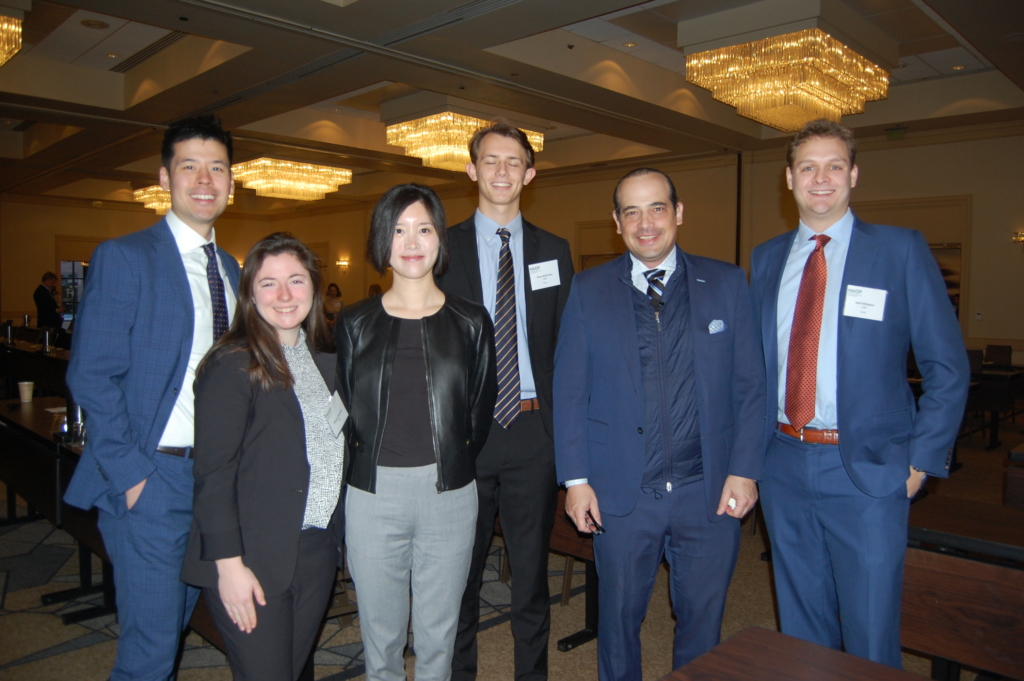Some of the same characteristics that drove office employees away from office space located in central business districts during the pandemic will also spur a large-scale return. Increasingly, workers want to be back in environments where they can experience serendipitous encounters and opportunities to collaborate or socialize with colleagues. Heightened office productivity and efficiency and the proximity bias phenomenon (in which employees working in the office are treated better than those still operating remotely) are additional factors favoring a comeback. Those were some of the findings presented by Spencer Levy, Global Chief Client Officer and Senior Advisor for CBRE, and members of the CBRE research team at this week’s Capital Stack seminar hosted by NAIOP Maryland at The Sheraton Baltimore North Hotel.

Spencer Levy, Global Chief Client Officer and Senior Advisor for CBRE, and members of the CBRE research team at Capital Stack on December 14, 2021.
“How long have workers that come into the office been treated better than those that don’t?” Levy asked the audience. “The answer is forever. What employers want more than anything is productivity and efficiency, and that is difficult to measure when people work from home. Our research indicates that two-thirds of the workforce is lonely working from home and cannot wait to return. And we expect things to normalize early next year. The high density and personal encounters that so many were running away from during the pandemic are the same things people are now craving.”
Levy presented data that indicated the average number of days spent in the traditional office pre-pandemic was 4.4 per week, a number that has now dropped to 3.5. However, this has been offset by companies requesting a de-densification of existing office space for health reasons, with the average 8,700 square foot office space swelling to 9,100 square feet of space.
Law firms have been negatively impacted the hardest and given up space due to the high volume of employees working hybrid or completely remote. The typical law office is comprised of older professionals and young, up-and-coming attorneys, and both have been fleeing the traditional office space. “With so many law firms located in Washington, D.C., our nation’s capital is still reeling from the pandemic,” he added.
Levy and the CBRE research team shared other insights during the NAIOP Maryland event:
- People moved away from big cities during the pandemic, with many choosing areas known for high technology talent. Areas that benefitted included Raleigh-Durham, Portland and Baltimore.
- Inflation seems to be rampant now, but Levy expects this to calm down by the end of next year. The reason? Our country is becoming increasingly older and that segment of the population tends to spend less.
- Levy sees tremendous value in open-air shopping centers, rather than the grocery-anchored venues that most experts tend to prefer.
- LEED and Energy Star projects are not green enough anymore. There is a growing demand for office buildings constructed of wood timber because their carbon footprint is 90% less per cubic square foot than for those projects constructed of steel.
- KPMG conducted a survey asking companies if they needed more or less office space. Pre-pandemic, 70% of firms indicated they would require less space. Now, only 17% say they do. A key driver of that change is shifting attitudes among employers. Last year, companies were looking at the future in an extremely pessimistic manner. That sentiment seems to have changed.
- Wei Xie of CBRE explained that more than 135 million square feet of office space was ‘lost’ or given back to the landlord during the pandemic (an amount that represents double the total in the Baltimore metro area). In Baltimore, total vacancy rate is 16.5%, accounting for more than 11 million square feet of space. However, just 18 buildings account for 25% of the total vacant space.
- Xie also discussed occupier sentiment data. Sixty-six percent of all employees expect to work in a hybrid model going forward. Fifty-two percent of all employees in the D.C. area would like to remain working from home.
- Locally, there is good news about the direction of our economy. Open Table reports that reservations are now 65% – and climbing – of reservation levels two years ago. Traffic at BWI Airport stands at 79% of pre-pandemic levels. MARC and Light Rail, however, are only operating at 23% of pre-pandemic levels.
- Industrial remains the star in the commercial real estate asset class, according to information presented by Jack Pellington at CBRE. Supply cannot keep up with demand and he terms the condition an “omni-shortage.” Rates for industrial space have risen 10.4% over the past year – the largest increase in two decades – and the vacancy rate in Baltimore currently stands at 3.4%, which is a historic low.